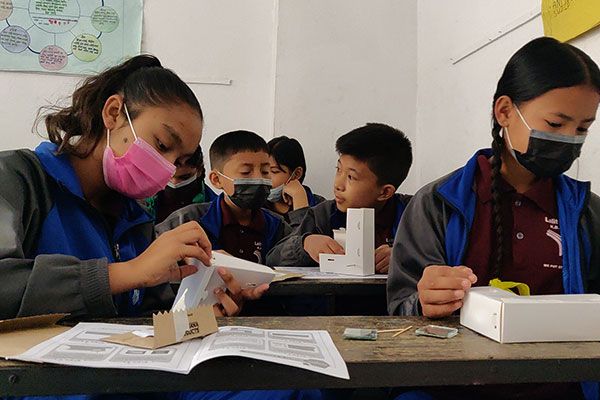
Funded by
The Lego Foundation
Implementing partner
Tufts University & Karkhana Global
Year
2021- 2023
What is PEBL?
PEBL, a research study, examined creating playful learning experiences through engineering education in low resource schools and communities. Led by Karkhana Samuha and Karkhana Global in Nepal, this Tufts University study was also conducted in Rwanda and the United States
Achievements and Highlights
-
Catalyzed a self sustaining Community of Practice of educators to support learning through play
-
Developed resources to ensure continuity and scalability, including a digital platform lessons plans, a teacher guide and student activity sheets
-
Enhanced educators digital fluency and capacity to utilize resources for self-directed professional development
-
Increased engagement of female educators and students with STEM practices
-
Improved capacity of local manufacturing through co-creation and knowledge sharing

Why Play?
The world never stops changing, so how do we prepare children to navigate it? We let them PLAY. Children thrive on PLAY. Given the chance to think, negotiate, adapt to new rules and try again when things don’t go to plan, children develop essential skills that’ll last a lifetime. When children play, it unlocks their curiosity - setting them up to become lifelong learners. Play boosts mental well-being in children and play is how children learn naturally. The evidence keeps growing that playing helps children master all the skills they need to thrive in our fast-moving, ever-changing world.
Why Engineering?
Engineering tackles problems in the world and how we, as humans, create solutions by leveraging multiple disciplines like science, math, psychology, and many more. Students of all ages are capable of engineering, and their ideas can be used to inform their design.
Engineering education emphasizes open-ended iterative problem solving and encourages children to learn from failure. It allows students to identify problems, research and brainstorm solutions, create and test prototypes, make improvements and share their work.
Testimonials

Tilak Sharma
Teacher, High New Vision Academy
I reflect on how my pedagogy has changed. I used to think silent classes were good, but now I question classrooms where only the teacher talks. I think interaction is essential for students to learn.

Rupa Manandhar
Principal, Panchakanya Madhyamik Vidhyala
Our students were building a catapult and most of them were working on more or less the same design that was modeled in the activity sheet. We ran out of masking tapes and they couldn't hold the sticks together as shown in the activity sheet. The students started trying out different ways to hold the catapult together. All the groups tried multiple approaches and all of them came up catapults of different designs. Some of the designs were actually sturdier than the previous ones with the masking tape. It was really interesting to see how sometimes limitations could force children to be creative and try out different things and come up with really good solutions. For me as a teacher, each PEBL lesson I deliver brings new insights into learning.

Gopal Bhandari
Co-founder, Charles Darwin Academy
Students who struggle with academics, who score low grades, and hardly engage in regular classes, are the ones that actively engage and excel in the PEBL hands-on lessons. This has made me question the effectiveness of our teaching methods. I have realized that any child can learn if the method is suitable.

Sabina Adhikari
Teacher, Lalit Kalyan Lower Secondary School
Our school does not have a science lab. Through PEBL, I was able to teach science lessons such as chromatography and periscope with hands-on materials. I have started to tackle challenges creatively and to design my own lesson plans utilizing limited materials after being part of this program.

Sujan Tamang
Lalit Kalyan Lower Secondary School
In our second PEBL session, we learned to make catapult. It was very exciting to design and build a catapult. I felt very happy when I successfully made a slingshot style catapult. I enjoyed the whole process and wanted to make a catapult that could throw more than one stone bullet at a time. After multiple tries, I was able to come up with a catapult that could throw multiple stone bullets at the same time.



3000+
Children learned through PLAY
1499
low resource learning kits manufactured
52
teachers engaged in the learning community
150+
lessons delivered in playful engineering based methods









